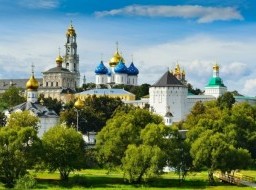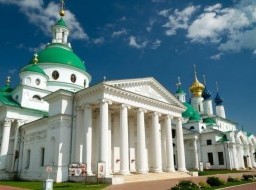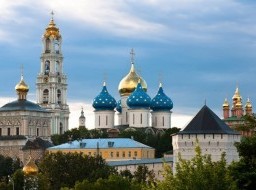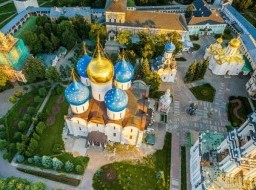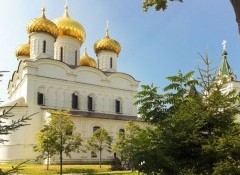Matryoshka Factory
The Russian nesting dolls turned Sergiev Posad into the fantastic «toy capital». It happened before the revolution, but even today the skilled craftsmen can please us with the skillfully made toys. The known factory of toys produces the fabulous classical Russian nesting dolls. There in the museum we can see many old Russian nesting dolls like "An old man", set of 8 pieces matryoshka, "Getman", 8 pieces se of nested doll, matryoshka "The tale about turnip" and others. Nobody knows exactly when the first Russian nesting doll appeared in Sergiev Posad. They say that Saint Sergiy Radonezhsky himself was carving and giving to the children the wooden toys. The principle of making dolls remains unchanged until the present time, keeping all the tricks of turning skill of Russian craftsmen. The doll blank overcomes though up to 15 operations in the hands of a turner before becoming a finished doll. Traditionally, a matryoshka was given to newborns to wish them a long and prosperous life. Two hundred years before the appearance of the Russian nesting dolls people in Sergiev Posad were already engaged in toy craft. In XV century pilgrims were bringing horses, girls in kokoshniks, tilting dolls from the monastery. Both tsar's and peasant's children were playing with them. The craft reached its flourishing in the end of XVIII – beginning of XIX centuries. The first matryoshka very much resembles the matryoshkas found in gift shops worldwide today. It is a small wooden doll, almost perfectly cylindrical, painted to resemble a peasant woman in a traditional sarafan dress holding a rooster. She opens to reveal a smaller doll, which opens in turn to reveal yet another doll, and so on. In total, there are several dolls in addition to the mother doll; they consist of several girls dressed in similar fashion, a boy doll, and a tiny baby at the center. Each doll wears brightly colored clothing and bears a small smile, pink cheeks, blonde hair, and a headscarf. Matryoshka first appeared in Russia in the late 1800's. However, the concept of nested items did not originate in Russia. Nested boxes are known to have been produced in China as far back as the 11th century. In the 1700s, nested dolls appeared in China and Japan. These sets were incredible with the smallest doll being about the size of a grain of rice. The popularity of the matryoshka spread quickly. The matryoshka's timing was no accident. The late 1800s was a time of emerging world identity for Russia. Art and new trends were of great interest and the Russian style was developed. Prominent artists were determined to create a style that was distinctively Russian but, also, represented Russia's folk heritage and traditions. Many of these artists fathered artistic and cultural centers and studios. In XIX-th century the Russian nesting dolls started being manufactured in the capital workshop «Children's education», later the painting of the Russian nesting dolls was mastered in Sergiev Posad. At this time that very type of the Russian nesting doll named "Zagorskaya" (in honor of the old name of this city), or the Sergiev Posad Russian nesting doll was born. The Russian nesting doll from Sergiev Posad had a special color which the local masters adhere even today. At the same time the interest to this wonderful toy caused in the Russian centers of ancient crafts the appearance of the other variants for the painted Russian nesting doll. Gradually the very picturesque, over gilded Russian nesting doll from Sergiev Posad was replaced with the quieter variant: painting with the red, yellow, green and dark blue colors with the thin black contouring. The faces of the early matryoshka dolls of Sergiev Posad were oval and strict. Sometimes a nesting doll portrayed the whole family with numerous children and members of households. Some matryoshkas were devoted to historical themes. The described boyars (old Russia noblemen), legendary heroes bogatirs (warriors), some dolls were devoted to book character. Masters of our time have inhaled their imagination in to the ancient craft, the toy has again blossomed out with all colors. Bright, joyful painting of each Russian nesting doll from Sergiev Posad is a gift for the child and a theme for the art historian. Russian nesting dolls from Sergiev Posad are very different. One doll has three sisters, and the other one has fifty of them. Maidens from one family can have a kitten in hands, and the others - a flower or a handkerchief. Each skilled craftsman makes the Russian nesting doll with a specific face, the dress and environment. In 1918 the unique Museum of Russian and Foreign Toys was opened in Sergiev Posad. The first Russian matryoshka by S. Maliutin, famous Russian painter, is a part of its exhibition. Soon afterwards the Toys Research Institute was organized there as well. The remarkable samples of toys were created in this institute including 42 pieces matryoshka. 60- pieces nesting doll is consider being the biggest one among the matryoshkas of Sergiev Posad. Today matryoshka is the most sought after Russian souvenir and you can, also, find nested dolls in countries such as Poland, Germany and Italy. |

